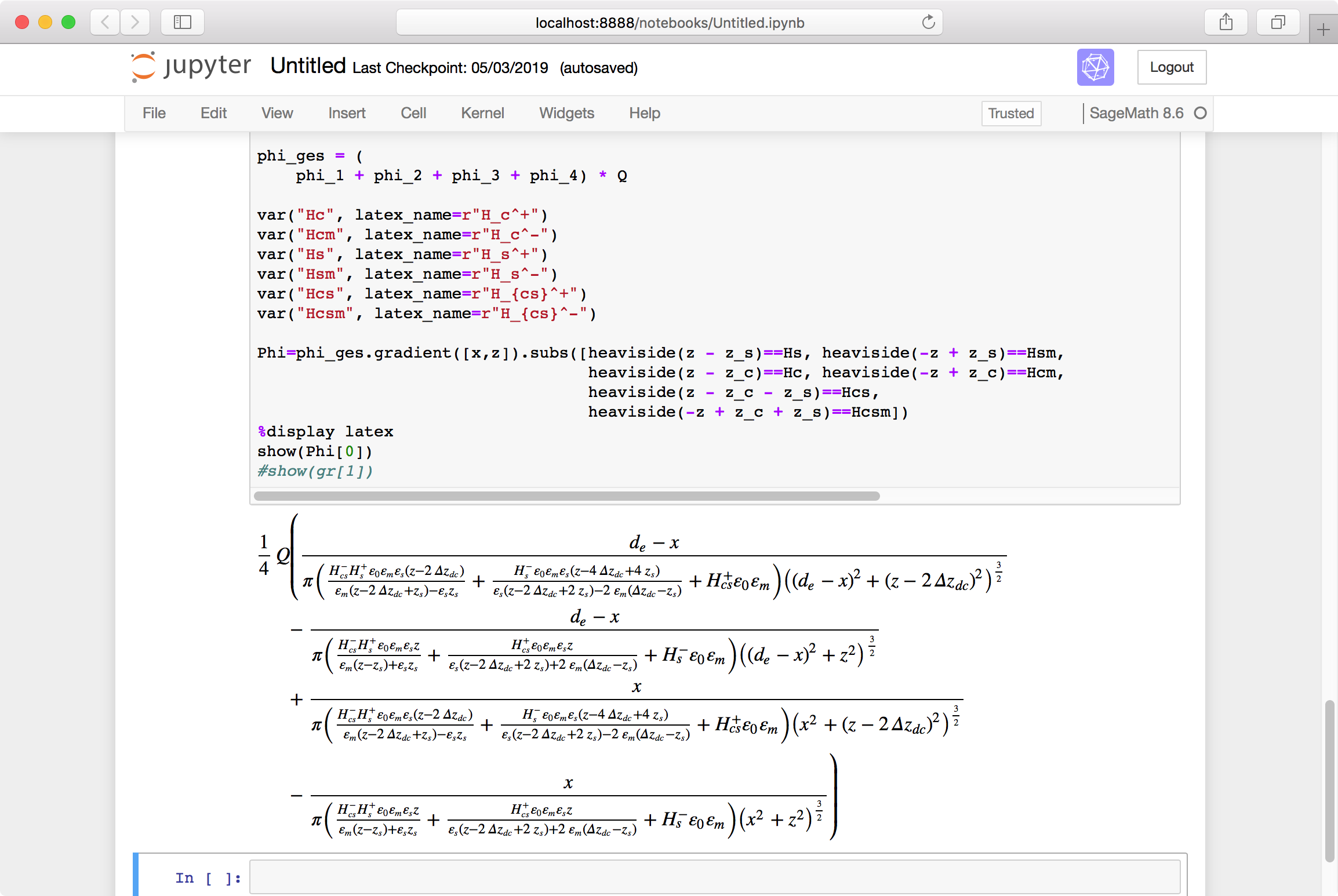grad() at glacial speed
I try to calculate grad() in this worksheet. It is really slow, and so far has not completed. Are there ways to speed it up? It should be mostly calculating the derivatives in x and z directions. Shouldnt that be comparatively quick?
x,z, z_c, z_s, d_e, epsilon_m, epsilon_s, v_ges, Q, U, a =var('x z z_c z_s d_e epsilon_m epsilon_s v_ges Q U a')
z_c = var('z_c', latex_name=r'\varDelta z_{dc}')
z_m = var('z_m', latex_name=r'\varDelta z_{ds}')
epsilon_0 = var('epsilon_0', latex_name=r'\varepsilon_0')
epsilon_s = var('epsilon_s', latex_name=r'\varepsilon_s')
epsilon_m = var('epsilon_m', latex_name=r'\varepsilon_m')
epsilon_Ersatz(epsilon_1,epsilon_2,d_1,d_2) = epsilon_1*epsilon_2*(d_1+d_2)/(d_1*epsilon_2+d_2*epsilon_1)
phi(epsilon, Q, r) = 1/(4*pi*epsilon)*Q/r
latex( SR.symbol ('phi') == phi)
phi_1 = phi(heaviside( z_s -z ) * epsilon_0*epsilon_m
+ heaviside( z- z_s ) * heaviside(z_c + z_s -z) * epsilon_0*epsilon_Ersatz(epsilon_m, epsilon_s, z_s , z-z_s)
+ heaviside( z -(z_c + z_s)) * epsilon_0*epsilon_Ersatz(epsilon_m, epsilon_s, (z-2*(z_c-z_s)), 2*(z_c-z_s)),
1, sqrt(x^2 + z^2)
)
phi_2 = phi(heaviside( z_s -z ) * epsilon_0*epsilon_m
+ heaviside( z- z_s ) * heaviside(z_c + z_s -z) * epsilon_0*epsilon_Ersatz(epsilon_m, epsilon_s, z_s , z-z_s)
+ heaviside( z -(z_c + z_s)) * epsilon_0*epsilon_Ersatz(epsilon_m, epsilon_s, ( z -2*(z_c-z_s)), 2*(z_c-z_s)),
-1, sqrt((d_e-x)^2 + z^2)
)
phi_3 = phi(heaviside( z_s -z) * epsilon_0*epsilon_Ersatz(epsilon_m, epsilon_s, (-z +2*(z_c-z_s)), 2*(z_c-z_s))
+ heaviside( z- z_s ) * heaviside(z_c + z_s -z) * epsilon_0*epsilon_Ersatz(epsilon_m, epsilon_s, z_s , 2*z_c-z_s -z)
+ heaviside( z -(z_c + z_s)) * epsilon_0*epsilon_m,
-1, sqrt((2*z_c-z)^2+x^2))
phi_4 = phi(heaviside( z_s -z) * epsilon_0*epsilon_Ersatz(epsilon_m, epsilon_s, (-z +2*(z_c-z_s)), 2*(z_c-z_s))
+ heaviside( z- z_s ) * heaviside(z_c + z_s -z) * epsilon_0*epsilon_Ersatz(epsilon_m, epsilon_s, z_s , 2*z_c-z_s -z)
+ heaviside( z -(z_c + z_s)) * epsilon_0*epsilon_m,
1, sqrt((2*z_c-z)^2+(d_e -x)^2))
phi_ges = (
phi_1 + phi_2 + phi_3 + phi_4) * Q
latex(phi_ges)
from sage.manifolds.operators import * # to get the operators grad, div, curl, etc.
S.<x,z> = EuclideanSpace(2)
Phi = S.scalar_field(phi_ges, name='Phi')
print((-grad(Phi)).display())


